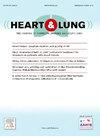区分 1 型和 2 型心肌梗死的生物标志物特征。
IF 2.4
4区 医学
Q2 CARDIAC & CARDIOVASCULAR SYSTEMS
引用次数: 0
摘要
背景:在入院和住院期间区分1型心肌梗死(T1MI)和2型心肌梗死(T2MI)至关重要,以避免不必要的侵入性检查和不适当的急性心脏科入院。目的:该研究的目的是从常用的生物标志物中定义一个简单的特征来区分T1MI和T2MI。方法:我们前瞻性地纳入了一项观察性研究,213名临时诊断为非st段抬高急性心肌梗死(NSTEMI)的连续患者住进了心内科。最终诊断为T1MI, T2MI和非缺血性急性心肌损伤(NAMI)是基于临床和仪器检查结果。我们评估了高灵敏度的肌钙蛋白I (hs-cTnI)、肌酸激酶MB (CK-MB)、c反应蛋白(CRP)、降钙素原(PCT)、脑钠肽n端激素原(NTproBNP)。结果:最终诊断为T1MI的患者77例,T2MI的患者60例,NAMI的患者76例;平均年龄组间差异无统计学意义(73岁比71岁),T2MI/NAMI组中女性患病率更高(53%比34%,p < 0.01)。Hs-cTnI峰/正常上限(ULN)(559±770 vs 286±429;p = 0.04), hs-cTnI峰值/CRP比值(114±337∶83±430;p < 0.001), hs-cTnI峰值/PCT比值(12,592±21,467∶4,609±17,284;p < 0.001), hs-cTnI峰/NTproBNP比值(0.7±1.6∶0.3±0.6;hhs - ctni峰值/ULN(559±770∶271±412)区分T1MI与T2MI;p < 0.01), hs-cTnI峰/PCT比值(12,592±21,468∶3,570±12,469;p < 0.001), hs-cTnI峰/NTproBNP比值(0.7±1.6∶0.3±1.3;p < 0.001), hs-cTnI峰值/CRP(114±337∶48±288;p < 0.001)区分T1MI和T2MI + NAMI。Hs-cTnI峰值/PCT比值是T1MI的预测因子,多变量logistic回归分析(OR 1.03, 95% CI 1.01-1.06, p < 0.05),准确率为0.704 (95% CI 0.626-0.782, p < 0.001)。T2MI与NAMI无显著差异。结论:入院生物标志物特征可以区分NSTEMI患者的T1MI和T2MI。本文章由计算机程序翻译,如有差异,请以英文原文为准。
Biomarker profiles that differentiate type-1 and type 2 myocardial infarction
Background
It is crucial to distinguish type-1 myocardial infarction (T1MI) from type-2 myocardial infarction (T2MI) at admission and during hospitalization to avoid unnecessary invasive exams and inappropriate admissions to the acute cardiac care unit.
Objectives
The purpose of the study was to define a simple profile derived from commonly used biomarkers to differentiate T1MI from T2MI.
Methods
We prospectively enrolled in an observational study 213 iconsecutive patients with a provisional diagnosis of non-ST-elevation acute myocardial infarction (NSTEMI) admitted to the Cardiology Department. A final diagnosis of T1MI, T2MI, and non-ischemic acute myocardial injury (NAMI) was given based on clinical and instrumental findings. We assessed high-sensitivity Troponin I (hs-cTnI), Creatine Kinase MB (CK-MB), C-reactive protein (CRP), procalcitonin (PCT), N-Terminal prohormone of brain natriuretic peptide (NTproBNP).
Results
A final diagnosis of T1MI was assigned to 77 patients, T2MI to 60 patients, and NAMI to 76 patients; mean age was not significantly different between groups (73 vs. 71 years), female were more prevalent in the T2MI/NAMI group (53 % vs. 34 %, p < 0.01). Hs-cTnI peak/upper limit of normal (ULN) (559 ± 770 vs. 286 ± 429; p = 0.04), hs-cTnI peak/CRP ratio (114 ± 337 vs. 83 ± 430; p < 0.001), hs-cTnI peak/PCT ratio (12,592 ± 21,467 vs. 4,609 ± 17,284; p < 0.001), and hs-cTnI peak/NTproBNP ratio (0.7 ± 1.6 vs. 0.3 ± 0.6; p < 0.01) differentiated T1MI from T2MI Hs-cTnI peak/ULN (559 ± 770 vs. 271 ± 412; p < 0.01), hs-cTnI peak/PCT ratio (12,592 ± 21,468 vs. 3,570 ± 12,469; p < 0.001), hs-cTnI peak/NTproBNP ratio (0.7 ± 1.6 vs. 0.3 ± 1.3; p < 0.001) and hs-cTnI peak/CRP (114 ± 337 vs. 48 ± 288; p < 0.001) differentiated T1MI from T2MI + NAMI. Hs-cTnI peak/PCT ratio was a predictor of T1MI, a multivariable logistic regression analysis (OR 1.03, 95 % CI 1.01–1.06, p < 0.05) with an accuracy of 0.704 (95 % CI 0.626–0.782, p < 0.001). No significant differences between T2MI and NAMI were detected.
Conclusions
Admission biomarker profile may differentiate T1MI from T2MI in patients admitted for NSTEMI.
求助全文
通过发布文献求助,成功后即可免费获取论文全文。
去求助
来源期刊

Heart & Lung
医学-呼吸系统
CiteScore
4.60
自引率
3.60%
发文量
184
审稿时长
35 days
期刊介绍:
Heart & Lung: The Journal of Cardiopulmonary and Acute Care, the official publication of The American Association of Heart Failure Nurses, presents original, peer-reviewed articles on techniques, advances, investigations, and observations related to the care of patients with acute and critical illness and patients with chronic cardiac or pulmonary disorders.
The Journal''s acute care articles focus on the care of hospitalized patients, including those in the critical and acute care settings. Because most patients who are hospitalized in acute and critical care settings have chronic conditions, we are also interested in the chronically critically ill, the care of patients with chronic cardiopulmonary disorders, their rehabilitation, and disease prevention. The Journal''s heart failure articles focus on all aspects of the care of patients with this condition. Manuscripts that are relevant to populations across the human lifespan are welcome.
 求助内容:
求助内容: 应助结果提醒方式:
应助结果提醒方式:


